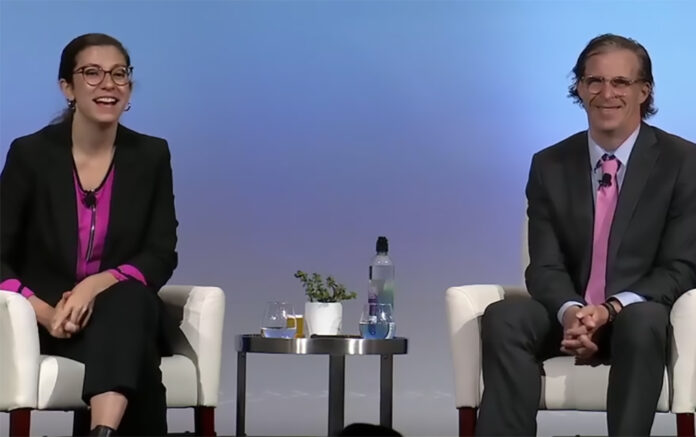Physician Dr David Sabgir and journalist Julia Hotz didn’t just present research—they threw down a challenge at today’s LM2025 conference in Grapevine, Texas. Their joint session, Walking the Walk: How Social Prescriptions for Movement, Nature & Belonging Improve Health, urged the audience to rethink the very essence of medicine.
Why limit prescriptions to pills, they asked, when the most transformative remedies might be found in walking groups, community ties, and time outdoors? This wasn’t a dry review of data; it was a rallying cry for a healthcare revolution built on connection, movement, and belonging.
Social prescribing is a healthcare-led referral system that connects patients to non-medical, community-based activities. Instead of defaulting to pharmaceuticals, clinicians can “prescribe” cycling lessons, walking groups, gardening, or time in nature. The idea is deceptively simple: health is shaped as much by our social environment as by our biology.
Hotz, author of The Connection Cure, framed the concept as a response to modern epidemics—loneliness, sedentary lifestyles, and chronic stress. Dr. Sabgir, founder of Walk with a Doc, illustrated how these prescriptions are already reshaping lives. Together, they argued that medicine must expand its toolkit to include interventions that restore connection, agency, and joy.
Personal experiences
The presentation highlighted case studies that put human faces to the statistics.
- Frank, the truck driver: At 60, living with type 2 diabetes and obesity, Frank was told he’d need insulin for life. Helpless and ashamed, he joined a ten-week cycling course. He lost 100 pounds, adopted a healthier diet, and now rides biweekly with a “chain gang” cycling group. He even volunteers with Diabetes UK, telling others, “If I can do it, anybody can.”
- Amanda, the swimmer: A 50-year-old woman battling major depressive disorder, loneliness, and grief, Amanda felt trapped in her own mind despite maximum-dose antidepressants. Prescribed sea swimming lessons, she reduced her medication, found a supportive crew, and rediscovered joy. “My life became bright again,” she said.
- Marilyn, the walker: At 54, with a BMI of 56.1 and poorly controlled diabetes, Marilyn could barely walk with a cane. Through a doctor-led walking group, she progressed from 200 steps to a full mile in just four weeks. Her empowerment was palpable: “I feel like I can do anything now.”
These stories underscore a truth often lost in clinical charts: health is not just about metrics, but about meaning.
Compelling evidence
The anecdotes are powerful, but the data is equally compelling.Studies show:
- Mental health gains: UK programs report reductions in anxiety and depression, while Canadian pilots saw a 48% drop in loneliness and a 34% decrease in frailty.
- Physical health improvements: Participants in YMCA and Unite Us initiatives recorded 43% reductions in depression, 20% less social isolation, and up to 90% increases in physical activity. Blood pressure fell, stress levels dropped, and participants gained four “mentally healthy” days per month.
- Healthcare savings: In Ontario, social prescribing reduced GP visits by nearly half and emergency room visits by two-thirds, saving an estimated $268 million annually.
The message is clear: social prescriptions don’t just improve lives, they ease the burden on overstretched healthcare systems.
Walking with a doc
Dr. Sabgir’s Walk with a Doc program exemplifies how social prescribing can reshape medicine. With over 600 chapters across 48 states and 43 countries, these free monthly walks bring patients and physicians together outside the clinic. Each event begins with a short health talk, followed by a walk and conversation. Optional screenings and healthy snacks add value, but the real medicine is connection.
For physicians, the benefits are profound: reduced burnout, stronger patient relationships, and a renewed sense of purpose. As one walk leader put it, “The relationships with my walkers are lifelong and have changed the way I will practice medicine, indefinitely.” Nature as Medicine
The presentation also highlighted initiatives like ParkRx, which encourage patients to spend time outdoors. Research into “forest bathing” (Shinrin-yoku) shows measurable reductions in stress hormones, improvements in immune function, and enhanced mood. Gardening programs have been linked to neuroplasticity and cognitive gains. These findings remind us that nature is not a luxury—it is a necessity for human health.
The path forward
Integrating social prescribing into clinical care requires systemic change. It means training link workers, building partnerships with community organizations, and shifting reimbursement models to value prevention and wellbeing. But the payoff is immense: healthier patients, stronger communities, and more sustainable healthcare.
Hotz and Sabgir’s presentation was not just about evidence, but about imagination. It asked us to picture a healthcare system where prescriptions include walking groups, art classes, or time in the forest. A system where doctors are not just gatekeepers of medication, but facilitators of connection.
Editorial comment …
As lifestyle medicine gains traction, social prescribing feels less like a fringe idea and more like an inevitable evolution. The LM205 presentation made clear that the future of healthcare lies in bridging medicine with community, biology with belonging.
In an era where loneliness is declared an epidemic by the U.S. Surgeon General, and where chronic disease drains both lives and budgets, the prescription pad must expand. Pills may treat symptoms, but movement, nature, and social connection heal the roots.
The challenge now is scale. Programs like Walk with a Doc and ParkRx show what’s possible, but policymakers, insurers, and clinicians must embrace these models. The evidence is there. The stories are there. What’s needed is the will to walk the walk.





